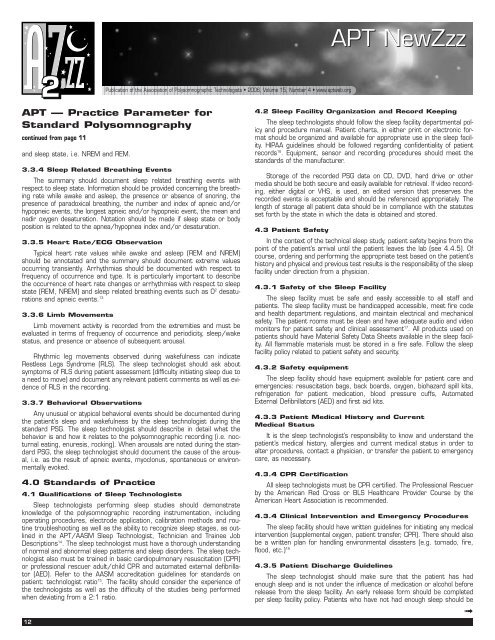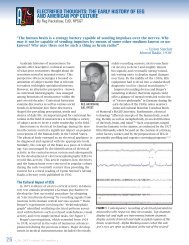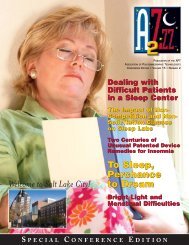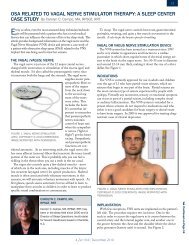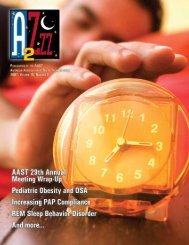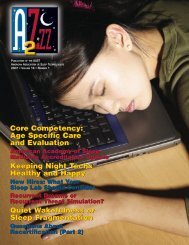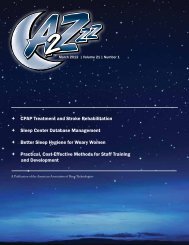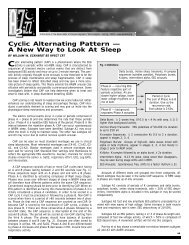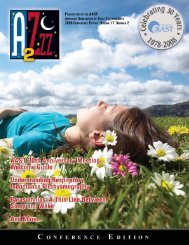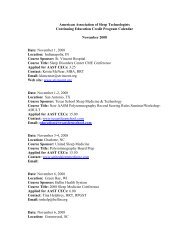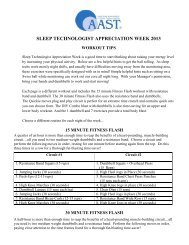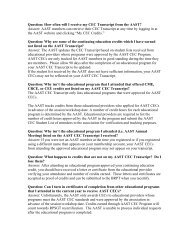APT Practice Parameter for Standard Polysomnography APT ...
APT Practice Parameter for Standard Polysomnography APT ...
APT Practice Parameter for Standard Polysomnography APT ...
- No tags were found...
You also want an ePaper? Increase the reach of your titles
YUMPU automatically turns print PDFs into web optimized ePapers that Google loves.
<strong>APT</strong> NewZzzPublication of the Association of Polysomnographic Technologists • 2006, Volume 15, Number 4 • www.aptweb.org<strong>APT</strong> — <strong>Practice</strong> <strong>Parameter</strong> <strong>for</strong><strong>Standard</strong> <strong>Polysomnography</strong>continued from page 11and sleep state, i.e. NREM and REM.3.3.4 Sleep Related Breathing EventsThe summary should document sleep related breathing events withrespect to sleep state. In<strong>for</strong>mation should be provided concerning the breathingrate while awake and asleep, the presence or absence of snoring, thepresence of paradoxical breathing, the number and index of apneic and/orhypopneic events, the longest apneic and/or hypopneic event, the mean andnadir oxygen desaturation. Notation should be made if sleep state or bodyposition is related to the apnea/hypopnea index and/or desaturation.3.3.5 Heart Rate/ECG ObservationTypical heart rate values while awake and asleep (REM and NREM)should be annotated and the summary should document extreme valuesoccurring transiently. Arrhythmias should be documented with respect tofrequency of occurrence and type. It is particularly important to describethe occurrence of heart rate changes or arrhythmias with respect to sleepstate (REM, NREM) and sleep related breathing events such as O 2 desaturationsand apneic events. 133.3.6 Limb MovementsLimb movement activity is recorded from the extremities and must beevaluated in terms of frequency of occurrence and periodicity, sleep/wakestatus, and presence or absence of subsequent arousal.Rhythmic leg movements observed during wakefulness can indicateRestless Legs Syndrome (RLS). The sleep technologist should ask aboutsymptoms of RLS during patient assessment (difficulty initiating sleep due toa need to move) and document any relevant patient comments as well as evidenceof RLS in the recording.3.3.7 Behavioral ObservationsAny unusual or atypical behavioral events should be documented duringthe patient’s sleep and wakefulness by the sleep technologist during thestandard PSG. The sleep technologist should describe in detail what thebehavior is and how it relates to the polysomnographic recording (i.e. nocturnaleating, enuresis, rocking). When arousals are noted during the standardPSG, the sleep technologist should document the cause of the arousal,i.e. as the result of apneic events, myoclonus, spontaneous or environmentallyevoked.4.0 <strong>Standard</strong>s of <strong>Practice</strong>4.1 Qualifications of Sleep TechnologistsSleep technologists per<strong>for</strong>ming sleep studies should demonstrateknowledge of the polysomnographic recording instrumentation, includingoperating procedures, electrode application, calibration methods and routinetroubleshooting as well as the ability to recognize sleep stages, as outlinedin the <strong>APT</strong>/AASM Sleep Technologist, Technician and Trainee JobDescriptions 14 . The sleep technologist must have a thorough understandingof normal and abnormal sleep patterns and sleep disorders. The sleep technologistalso must be trained in basic cardiopulmonary resuscitation (CPR)or professional rescuer adult/child CPR and automated external defibrillator(AED). Refer to the AASM accreditation guidelines <strong>for</strong> standards onpatient: technologist ratio 15 . The facility should consider the experience ofthe technologists as well as the difficulty of the studies being per<strong>for</strong>medwhen deviating from a 2:1 ratio.124.2 Sleep Facility Organization and Record KeepingThe sleep technologists should follow the sleep facility departmental policyand procedure manual. Patient charts, in either print or electronic <strong>for</strong>matshould be organized and available <strong>for</strong> appropriate use in the sleep facility.HIPAA guidelines should be followed regarding confidentiality of patientrecords 16 . Equipment, sensor and recording procedures should meet thestandards of the manufacturer.Storage of the recorded PSG data on CD, DVD, hard drive or othermedia should be both secure and easily available <strong>for</strong> retrieval. If video recording,either digital or VHS, is used, an edited version that preserves therecorded events is acceptable and should be referenced appropriately. Thelength of storage all patient data should be in compliance with the statutesset <strong>for</strong>th by the state in which the data is obtained and stored.4.3 Patient SafetyIn the context of the technical sleep study, patient safety begins from thepoint of the patient’s arrival until the patient leaves the lab (see 4.4.5). Ofcourse, ordering and per<strong>for</strong>ming the appropriate test based on the patient’shistory and physical and previous test results is the responsibility of the sleepfacility under direction from a physician.4.3.1 Safety of the Sleep FacilityThe sleep facility must be safe and easily accessible to all staff andpatients. The sleep facility must be handicapped accessible, meet fire codeand health department regulations, and maintain electrical and mechanicalsafety. The patient rooms must be clean and have adequate audio and videomonitors <strong>for</strong> patient safety and clinical assessment 17 . All products used onpatients should have Material Safety Data Sheets available in the sleep facility.All flammable materials must be stored in a fire safe. Follow the sleepfacility policy related to patient safety and security.4.3.2 Safety equipmentThe sleep facility should have equipment available <strong>for</strong> patient care andemergencies: resuscitation bags, back boards, oxygen, biohazard spill kits,refrigeration <strong>for</strong> patient medication, blood pressure cuffs, AutomatedExternal Defibrillators (AED) and first aid kits.4.3.3 Patient Medical History and CurrentMedical StatusIt is the sleep technologist’s responsibility to know and understand thepatient’s medical history, allergies and current medical status in order toalter procedures, contact a physician, or transfer the patient to emergencycare, as necessary.4.3.4 CPR CertificationAll sleep technologists must be CPR certified. The Professional Rescuerby the American Red Cross or BLS Healthcare Provider Course by theAmerican Heart Association is recommended.4.3.4 Clinical Intervention and Emergency ProceduresThe sleep facility should have written guidelines <strong>for</strong> initiating any medicalintervention (supplemental oxygen, patient transfer, CPR). There should alsobe a written plan <strong>for</strong> handling environmental disasters (e.g. tornado, fire,flood, etc.) 184.3.5 Patient Discharge GuidelinesThe sleep technologist should make sure that the patient has hadenough sleep and is not under the influence of medication or alcohol be<strong>for</strong>erelease from the sleep facility. An early release <strong>for</strong>m should be completedper sleep facility policy. Patients who have not had enough sleep should be➟


